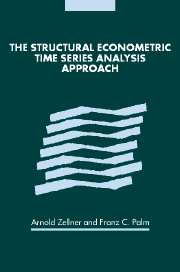Book contents
- Frontmatter
- Contents
- List of contributors
- Acknowledgments
- Introduction
- Part I The SEMTSA approach
- Part II Selected applications
- Part III Macroeconomic forecasting and modeling
- Part IV Disaggregation, forecasting, and modeling
- 20 Using Bayesian techniques for data pooling in regional payroll forecasting (1990)
- 21 Forecasting turning points in metropolitan employment growth rates using Bayesian techniques (1990)
- 22 A note on aggregation, disaggregation, and forecasting performance (2000)
- 23 The Marshallian macroeconomic model (2000)
- 24 Bayesian modeling of economies and data requirements (2000)
- Subject index
- Author index
- References
21 - Forecasting turning points in metropolitan employment growth rates using Bayesian techniques (1990)
Published online by Cambridge University Press: 24 October 2009
- Frontmatter
- Contents
- List of contributors
- Acknowledgments
- Introduction
- Part I The SEMTSA approach
- Part II Selected applications
- Part III Macroeconomic forecasting and modeling
- Part IV Disaggregation, forecasting, and modeling
- 20 Using Bayesian techniques for data pooling in regional payroll forecasting (1990)
- 21 Forecasting turning points in metropolitan employment growth rates using Bayesian techniques (1990)
- 22 A note on aggregation, disaggregation, and forecasting performance (2000)
- 23 The Marshallian macroeconomic model (2000)
- 24 Bayesian modeling of economies and data requirements (2000)
- Subject index
- Author index
- References
Summary
Introduction
Zellner, Hong, and Gulati (1990) and Zellner and Hong (1989) formulated the problem of forecasting turning points in economic time series using a Bayesian decision theoretic framework. The methodology was … applied by Zellner, Hong, and Min (1990) (hereafter ZHM) to a host of models to forecast turning points in the international growth rates of real output for eighteen countries over the period 1974–86. They compared the performance of fixed parameter autoregressive leading indicator models (FP/ARLI), time-varying parameter autoregressive leading indicator models (TVP/ARLI), exponentially weighted autoregressive leading indicator models (EW/ARLI), and a version of each of these models that includes a world income variable – FP/ARLI/WI, TVP/ARLI/WI, EW/ARLI/WI. In addition, they implemented a pooling scheme for each of the models. A similar host of models is analysed here in order to assess whether these techniques hold promise for forecasting turning points in regional labor markets.
The innovative aspect of the ZHM study is not the models employed, but the use of the observations along with an explicit definition of a turning point, either a downturn (DT) or upturn (UT). This allows for a Bayesian computation of probabilities of a DT or UT given the past data from a model's predictive probability density function (pdf) for future observations. After computing these probabilities from the data, they can be used in a decision theoretic framework along with a loss structure in order to produce an optimal turning point forecast.
- Type
- Chapter
- Information
- The Structural Econometric Time Series Analysis Approach , pp. 637 - 655Publisher: Cambridge University PressPrint publication year: 2004

